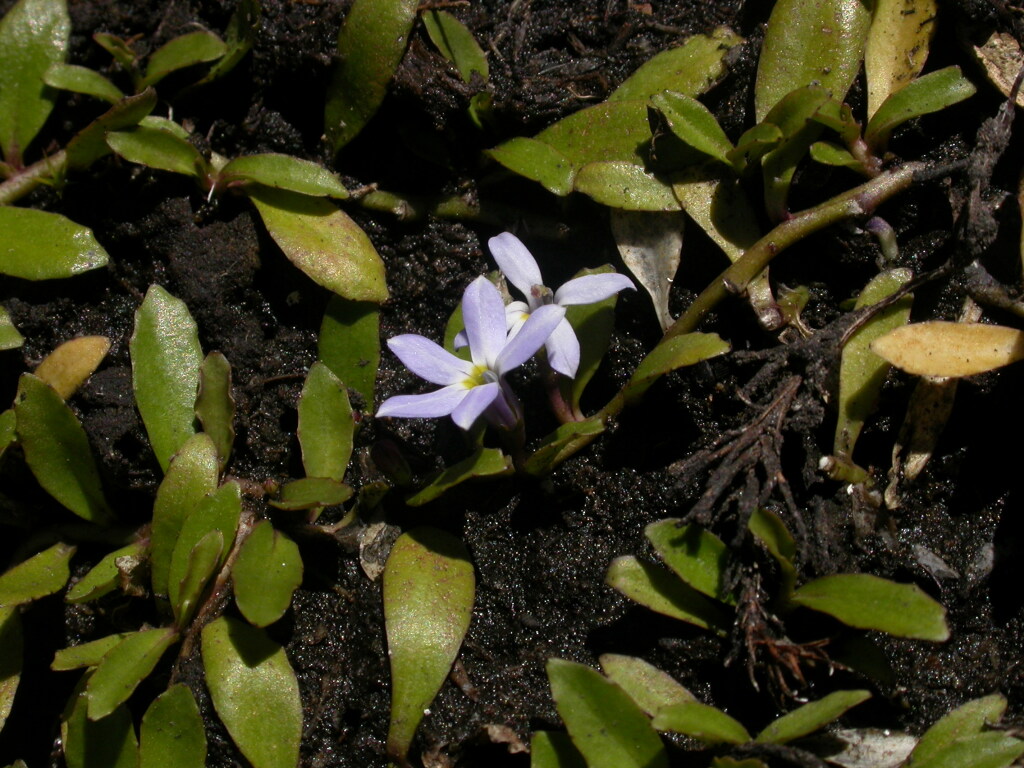Lobelia surrepens
Hook.f. Mud PratiaMat-forming perennial, glabrous or young growth minutely pubescent; stems rooting at the nodes. Leaves c. distichous, obovate to spathulate, 4–31 mm long, 2.4–9.5 mm wide, c. entire with scattered minute indentations, rarely 1-few-toothed, often thick textured, base tapered gradually; petiole 0–5 mm long. Flowers irregularly spaced; pedicels 1.5–60 mm long, glabrous or minutely pubescent. Calyx-lobes 0.9–2 mm long, entire; corolla weaky zygomorphic, 5–11 mm long, white or blue-lilac tinged, lobes subequal but upper 2 more deeply cleft, elliptic to oblanceolate-obovate, 3–7 mm long, 1.1–2.5 mm wide, tube 2–4 mm long, split to within 0.5–1 mm of the base, with fine retrorse hairs internally; filaments 2.5–3 mm long, anther tube 1.2–1.6 mm long, seta of 2 lower anthers 0.3–0.5 mm long. Fruit ellipsoid-globose, c. 3–5 mm long; seeds ellipsoid, slightly compressed, 0.7–1 mm long, light brown, reticulate. Fruits Feb.-Mar.
VVP, EGL, EGU, HSF, HNF, MonT, HFE, VAlp. NSW, ACT, Tas.
Lobelia surrepens superficially resembles Isotoma fluviatilis subsp. australis but differs in having the corolla-tube split to near the base; larger, more prominently reticulate seeds; a shorter indumentum on the inner surface of the corolla-tube; anther filaments attached only at base of corolla; and in lacking a crescent of darker pigment near the base of the lower corolla-lobes.
Lobelia surrepens is a variable species, particularly within populations from lower altitudes (e.g. Delegate River). Some plants at lower elevations have a more open habit, larger leaves, larger corollas and longer pedicels than typically found in most higher altitude populations. Wiecek (1992) recorded an undescribed species (Pratia sp. A) for Victoria, which apparently differed from L. surrepens in having unisexual flowers, shorter leaves, shorter pedicels, longer calyx-lobes, smaller corollas and smaller fruits. However, specimens assigned to Pratia sp. A appear to fall within L. surrepens as described above, and this taxon is not recognized here. No Victorian specimens with female flowers have been collected and the flowers assumed to be males may have been bisexual flowers prior to the emergence of the stigma from the anther tube. Field studies are required to clarify this interpretation.
Albrecht, D.E.; Walsh, N.G. (1999). Campanulaceae. In: Walsh, N.G.; Entwisle, T.J., Flora of Victoria Vol. 4, Cornaceae to Asteraceae, pp. 553–553. Inkata Press, Melbourne.
 Spinning
Spinning
